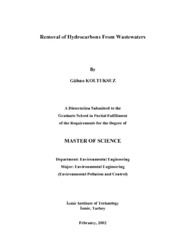Please use this identifier to cite or link to this item:
https://hdl.handle.net/11147/3643| Title: | Removal of Hydrocarbons From Wastewaters | Authors: | Koltuksuz, Gülsan | Advisors: | Ülkü, Semra | Publisher: | Izmir Institute of Technology | Abstract: | Wastewater of chemical industries and petrochemical spills are the main sources of hydrocarbon pollution. Benzene, toluene and o- xylene are generally found in petrochemical spills which effect the all livings in the environment because of its toxicity.This thesis was an investigation of benzene, toluene and o- xylene (nonpolar aromatics) adsorption on clinoptilolite rich natural zeolite and surfactant modified zeolite. The aim of surfactant modification was to make highly polar zeolite surface hydrophobic and thereby remove the hydrophobic benzene, toluene and o- xylene molecules from the aqueous phase with the help of hydrophobic attraction forces.Cationic surfactants Dodecyl Amine (DA), Tetramethylammonium (TMA+) and an anionic surfactant Sodium Dodecyl Sulfate (SDS) were used for surface modification.The degree of surface hydrophobicity was examined by calculating the change in Gibbs free energy of the zeolite-water system by using the contact angle and surface tension measurement results in the presence and absence of surface modification. For natural zeolite the mean contact angle value was found 7.76o. Modification by DA and TMA+ increased .m from 7.76o to 51.13o and 29.37o respectively at a concentration of M. In case of SDS, at the pH value of 4, there was only a slight increase from 7.76 o to 18.03 o at a concentration of M. Effect of these surfactants on interfacial tension at air water interface was also different from eachother. DA decreased the surface tension from 72.8 to 37 dynes/cm while TMA+ did not bring any change. This part of the study showed that the presence of surfactant makes zeolite surface more hydrophobic.In adsorption studies, natural zeolite removed 20% of hydrocarbons from water. Except toluene, there was an optimum time that the removal was high. Presence of surfactant was able to increase this percent up to 40% under some conditions depending on the surfactant and hydrocarbon type and concentration. The highest benzene adsorption was obtained with TMA+ modified zeolite. The sequence was benzene > toluene > o-xylene. In case of DA modified zeolite, on the other hand, oxylene was adsorbed more than the other hydrocarbons. The removal follows the order o- xylene > toluene > benzene in this case. | Description: | Thesis (Master)--Izmir Institute of Technology, Environmental Engineering, Izmir, 2002 Includes bibliographical references (leaves: 68-72) Text in English; Abstract: Turkish and English x, 72 leaves |
URI: | http://hdl.handle.net/11147/3643 |
| Appears in Collections: | Master Degree / Yüksek Lisans Tezleri Sürdürülebilir Yeşil Kampüs Koleksiyonu / Sustainable Green Campus Collection |
Files in This Item:
| File | Description | Size | Format | |
|---|---|---|---|---|
| T000046.pdf | MasterThesis | 695.91 kB | Adobe PDF |  View/Open |
CORE Recommender
Page view(s)
242
checked on Mar 31, 2025
Download(s)
96
checked on Mar 31, 2025
Google ScholarTM
Check
Items in GCRIS Repository are protected by copyright, with all rights reserved, unless otherwise indicated.